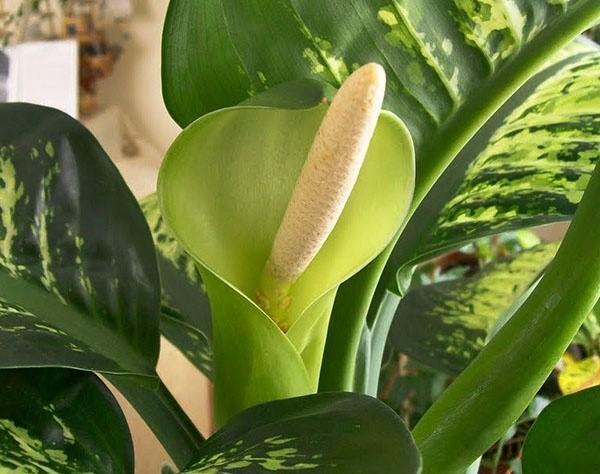Motley and slender beauty Dieffenbachia spotted
 Among the wide variety of species of evergreen shrub, there are more than 30 varieties, but the most common is spotted dieffenbachia. Experienced flower growers know what this plant is and how to care for it and are happy to share their knowledge.
Among the wide variety of species of evergreen shrub, there are more than 30 varieties, but the most common is spotted dieffenbachia. Experienced flower growers know what this plant is and how to care for it and are happy to share their knowledge.
Description of the variety
Dieffenbachia spotted - a bright representative of the aroid family. The flower is quite medium in size - unlike its tall relatives, reaching a height of up to 2 m, this variety grows no more than 1 m.
Despite its modest (by general standards) size, Dieffenbachia spotted is characterized by rapid growth and in just two years can become a full-fledged adult flower.
The variety is distinguished by large leaves, the length of which is 40 cm with a maximum width of 12 cm. They are attached to a thick central stem with short petioles (no longer than the leaf itself, or even shorter than it). There is a slight taper at the tip of the leaf, and it itself is usually bright green with white spots.
The homeland of spotted dieffenbachia is considered to be South and Central America.
At home, flowering diffebachia - the phenomenon is not very frequent, but when it occurs, a shortened peduncle appears at the top of the plant, consisting of a green veil and a yellowish cob inside it. Sometimes, after the end of flowering, a fruit forms - orange berries with a red tint, but most often the flower stalk dries out indoors.
Types of spotted dieffenbachia
On the basis of this variety, breeders have bred many hybrids that differ in color and leaf shape. The most popular ones are:
- Camilla - leaves with a white color in the center, and green - along the edge of the plate;
- Tropic Snow - yellow veins on dark green leaves;
- Tropic San - in the center of the leaf there are yellow-white streaks, and the edges are pure green;
- Rudolph Roers - the main color of the leaf is yellow-green, and there are dark veins in the center;
- Jupiter - the entire sheet is yellow-white.
Care features
When growing dieffenbachia, it should be borne in mind that spotted varieties need more light, otherwise they may lose their original color. Such a plant should not be placed deep into the room.
The optimum temperature for keeping a flower in winter is about 18 degrees, and in summer - no more than 25 degrees. The plant should be watered abundantly, but not very often, so that the roots do not rot and the leaves do not fall off. But spraying dieffenbachia (pictured) loves very much, especially in hot summer and during the heating season, when the room has dry air
From spring to autumn, the flower must be fertilized three times a month with complex mineral preparations... When dieffenbachia is old (the lower leaves fall off and the trunk is bare), it must be rejuvenated by cutting and rooting the top.